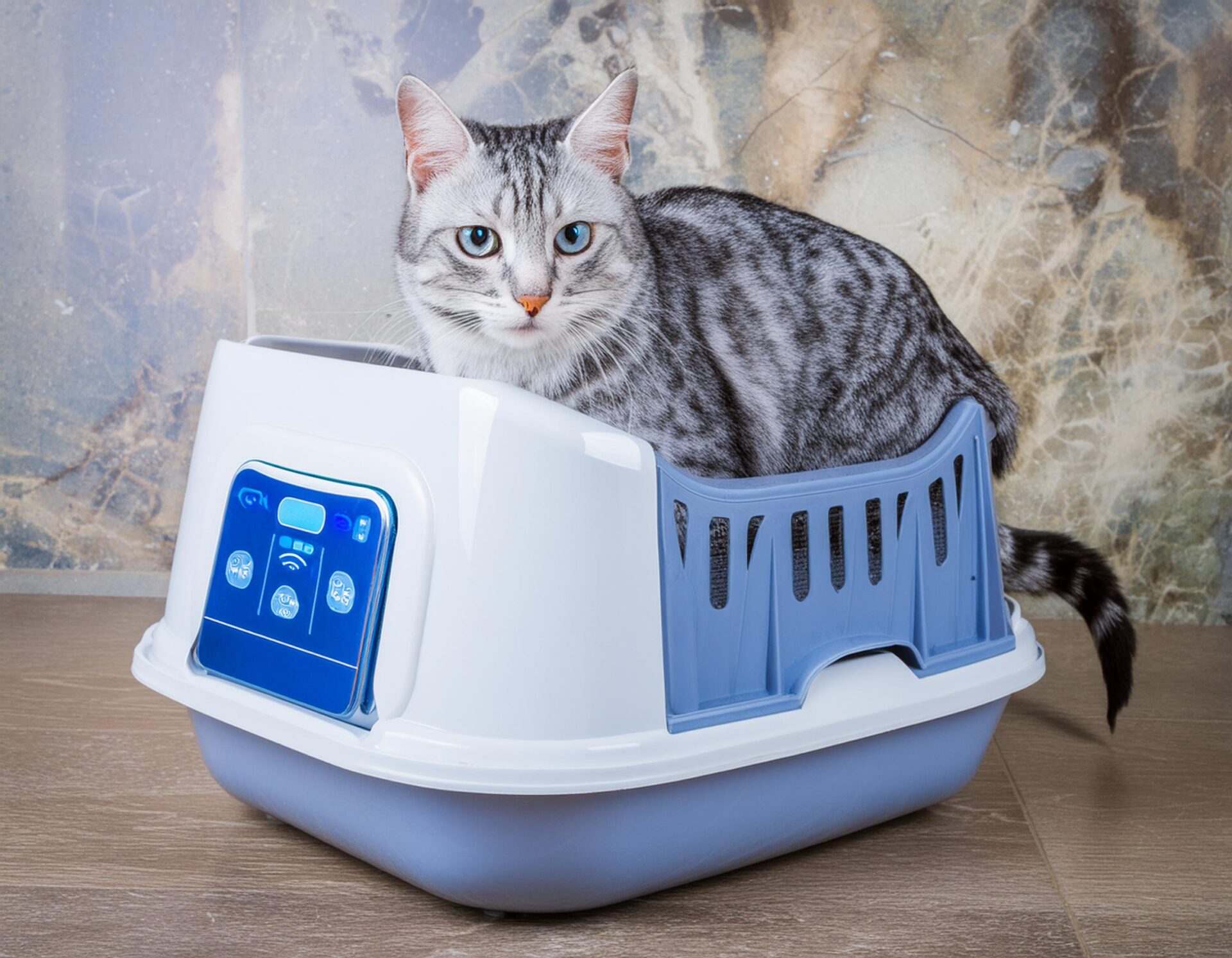Having a pet comes with its share of joy and challenges, one of which is ensuring our furry friends are comfortable and happy with their litter box setup. As dedicated pet owners, we understand how distressing it can be when a cat or dog isn’t using their litter box correctly. It’s not just a nuisance; it’s a sign that our pets might need our help. From selecting the right type of litter box that suits their needs to understanding the nuances of its placement and cleanliness, there’s quite a bit we need to consider for our pet’s toiletry habits.

Moreover, technological advancements have brought smart devices into the pet care sphere, including innovative litter box solutions that promise to make our lives easier and keep our pets satisfied. These smart litter boxes can help us track usage, automate cleaning, and even alert us to potential health issues. Combining such high-tech solutions with our understanding of our pets’ behavior and possible health concerns can make addressing litter box problems less of a headache.
Key Takeaways
- Proper litter box care is crucial for pet comfort and preventing issues.
- Smart devices offer innovative solutions for litter box management.
- Monitoring behavior and health can help address litter box avoidance.
Understanding Litter Box Issues
When we bring a smart device into our homes to help with pet care, understanding how it works is crucial, especially if it pertains to litter boxes. Smart litter boxes can provide us with insights and alerts about our cats’ bathroom habits, but we must be aware of the common litter box issues that can arise, and recognize the signs so we can take prompt action to keep our feline friends happy and healthy.
Identifying Common Problems
- Health-related issues: Cats with urinary tract infections, kidney problems, or other health concerns might start avoiding the litter box. A health check can rule out or confirm any medical problems.
- Litter box cleanliness: A dirty litter box can discourage use. Smart litter boxes often have indicators to inform us when it’s time to clean or replace the litter.
- Box location and type: Cats may prefer a quiet and private area. Some smart litter boxes are designed with this in mind, offering an enclosed space.
By staying on top of these issues, we ensure that our smart litter box is a help, not a hindrance.
Signs of Litter Box Avoidance
- Inconsistent use: A cat that sporadically uses its box may be expressing discomfort or dissatisfaction with the current setup.
- Accidents outside the box: Finding waste outside the litter box can signal a problem, whether behavioral or medical.
Understanding these signs is essential for us to maintain the health and hygiene of our pet and home environment, and to get the most out of our smart devices.
Choosing the Right Litter Box

Selecting the perfect litter box for your feline companion is crucial. We understand that it’s not just about the box itself—the choices you make can deeply affect your cat’s comfort and health. Let’s guide you through the essential considerations of size and design, along with the pros and cons of various litter types, all geared towards smart devices for our pet pals.
Size and Design Considerations
When we think about size, we’re aiming for a litter box that’s roomy enough for your cat to turn around easily without any hindrance. A general rule of thumb is to choose a box that is at least 1.5 times the length of your cat from nose to base of the tail. The design should also reflect ease of entry and exit, especially for kittens or senior cats that may require a low-sided box to accommodate their needs. Smart litter boxes, although pricier, can often bring us convenience with automated cleaning and tracking of usage patterns, which is something worth considering for our busy lifestyles.
- Recommended Dimensions: At least 13-15 inches wide for ample space
- Entry and Exit: Low sides can help kittens and senior cats
- Automated Options: Smart devices offer features like self-cleaning and usage tracking
Pros and Cons of Different Litter Types
The litter within the box is just as significant as the box itself. Clumping litter is popular for easy clean-up, but we must pay attention to how much we use—a depth of about 2-3 inches is typically preferred by cats. Meanwhile, crystal litter, often used in conjunction with smart litter boxes, may provide superior odor control and less frequent changes. However, it can be more costly and some cats might not prefer the texture.
- Clumping Litter: Easy to clean, needs 2-3 inches of depth
- Crystal Litter: Great odor control, pairs well with smart litter boxes, but more expensive and texture might not suit all cats
Remember, the right litter box and litter type can greatly improve the quality of life for our furry friends, and a smart litter box can be a game-changer for us as well.
Location and Maintenance

Imagine walking into a space that makes you feel welcome; that’s exactly how we want our furry friends to feel about their litter boxes. We know that a well-placed and meticulously maintained litter box is key to a harmonious home where pets and people are happy. Our smart devices for pets make this task easier.
Strategic Placement of Litter Boxes
Placement Tips:
- Avoid High Traffic Areas: Keep the litter box in a quiet corner to provide privacy and reduce stress.
- Accessibility: Ensure the litter box is easily accessible to your pet and not blocked by any obstacles.
- Multiple Floors, Multiple Boxes: If our home has more than one floor, we place a box on each level.
- Distance from Food: We never place the litter box near the pet’s food or water bowls, as that can discourage use.
By incorporating smart litter boxes into our homes, we’re able to keep track of its usage and ensure it’s always placed in the optimal location.
Cleaning Routines and Best Practices
Daily Maintenance:
- Scoop Daily: We remove waste from the litter box every day.
- Monitor: With smart litter boxes, we can receive notifications if the cleaning cycle is disrupted or if there’s an irregularity in usage patterns.
Deep Cleaning:
- Schedule Regular Cleans: We recommend a deep clean of the litter box every two weeks.
- Replace Litter: Completely replace the litter and clean the box with a mild detergent; avoid harsh chemicals that could deter your pet from using the box.
Embracing smart technology for pet maintenance tasks not only streamlines the process but also contributes to the wellbeing of our pets.
Behavioral Factors and Solutions

Have you ever found yourself puzzled by your cat’s sudden aversion to the litter box? We’re familiar with how distressing it can be. Let’s dive right into understanding the behavioral triggers and how to guide your feline friend back to good litter box habits with smart pet technology support.
Stress-Related Issues
Stress in cats can manifest as litter box avoidance. Changes in the home, conflicts with other pets, or disruptions in their routine can upset your cat. To combat this:
- Monitor Your Cat’s Environment: Use a smart pet environment monitor linked to your phone to keep an eye on temperature, humidity, and noise levels in their space, making adjustments to maintain a calm environment.
- Implement Calming Techniques: Consider smart diffusers that release feline pheromones to create a more relaxing atmosphere.
Training Techniques for Proper Use
Cats generally pick up on litter box usage quickly, but sometimes they need a little extra guidance. Here’s what we’ve found works well:
- Consistent Cleaning: With a self-cleaning litter box, you ensure the box remains clean, which is essential for encouraging its use.
- Positive Reinforcement: Reward-based gadgets can dispense treats for your cat when they use the litter box, reinforcing positive behavior.
Health Concerns Affecting Litter Box Use
Have you ever noticed a sudden change in your furry friend’s bathroom habits? This could be a sign of underlying health issues that need our immediate attention. Remember that our smart devices for pets can only do so much—sometimes, a visit to the vet is necessary for their well-being.
Medical Conditions That Impact Behavior
Several medical conditions can alter a cat’s litter box behavior. Urinary tract infections, for instance, can cause discomfort and result in a cat avoiding its litter box. Additionally, conditions such as kidney stones or a blockage may lead to the same aversion. Monitoring with devices like smart litter boxes, which track frequency and duration, helps us detect these changes early.
- Urinary Tract Infections (UTIs)
- Inflammatory Bowel Disease (IBD)
- Diabetes
- Kidney Issues
These conditions can cause symptoms like increased frequency of urination, difficulty urinating, or defecating outside the litter box. Our smart pet devices can alert us to unusual patterns that warrant further investigation.
When to Consult a Veterinarian
It’s crucial for us to consult with a veterinarian if:
- Our cat is avoiding the litter box consistently
- We notice any signs of distress or pain while they attempt to use the box
- There’s a presence of blood in the urine or stool
Early veterinary intervention can lead to a quick diagnosis and management plan, ensuring our cat’s health and happiness. Smart devices play a supporting role by tracking health metrics and alerting us to potential issues.
Frequently Asked Questions
Have you noticed changes in your cat’s litter box habits? We’ve gathered the top questions and focused on solutions that integrate smart devices for pets, so you can quickly identify and address litter box issues.
Why has my female cat stopped using the litter box?
Our feline friends can be finicky about cleanliness. If your female cat has stopped using her litter box, it’s possible that the box is not up to her standards. Consider a self-cleaning litter box, which can help maintain a consistently clean environment for her.
How can I retrain my cat to use the litter box?
To retrain your cat, start with positioning smart litter boxes on each floor of the house for easy access. These devices can send notifications to your phone when they need cleaning, ensuring the box is always inviting.
What should I do if my male cat is visiting the litter box frequently?
Frequent visits to the litter box by your male cat may indicate a health issue that needs veterinary attention. Meanwhile, monitoring litter box use with smart litter box sensors can give you precise data on his bathroom behaviors, helpful for both you and the vet.
What can be done when a cat refuses to poop in the litter box?
Inconsistent poop habits can be mitigated by using litter boxes that automatically adjust the amount of litter they contain. Some cats prefer a specific layer of litter, and these smart devices can help maintain the preferred depth.
How do I address my cat’s avoidance of the litter box for urination?
Cats avoiding the litter box for urination may be reacting to its location or cleanliness. A smart litter box can be placed in a quiet, accessible spot and can keep itself clean, encouraging your cat to use it.
What steps can I take if my cat won’t pee in the litter box?
Smart litter boxes also come equipped with health tracking. If your cat won’t pee in the litter box, these devices can alert you to changes in bathroom behavior, indicating it might be time to consult your vet.
